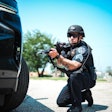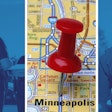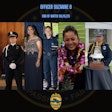In 2003, more than 4,700 pedestrians were killed in crashes with cars. Another 70,000 were injured. As populations grow, police must take a proactive stance to prevent car vs. pedestrian crashes.
There are four general factors that contribute to such crashes. The first two are obviously the car (and its driver) and the pedestrian; the third is the physical environment they share. Police planning can influence all three of these factors. The fourth factor, the weather, is beyond your control.
Jaywalking
The major contributing factor to pedestrian injuries and fatalities has nothing to do with the motor vehicle. Unsafe pedestrian actions are the major cause. A study out of Florida revealed that pedestrians are at fault 80 percent of the time. The umbrella term given to the most dangerous pedestrian action is "jaywalking." This term refers to any form of illegal street crossing by a pedestrian, encompasses crossing against the light, crossing where there is no crosswalk, and walking on the street.
Despite the strong link between jaywalking and serious pedestrian crashes, jaywalking enforcement remains an extremely low priority in most police departments. Law makers also view jaywalking as an afterthought. Jaywalking penalties are usually among the least severe on the books. As with all enforcement, violators evaluate the relatively low chance of being caught along with the low cost if they do get caught. For these reasons, jaywalking continues to occur almost unabated.
Collecting Information
While jaywalking is the general reason for the majority of car vs. pedestrian crashes, a directed response will have to pinpoint local causes. Determine how many car vs. pedestrian crashes occur and who is at fault.
Determining when car vs. pedestrian crashes occur will also assist in a targeted response. Certainly pedestrian traffic is different at 3 a.m. as opposed to 3 p.m. Research shows that most pedestrian injuries happen between 3 p.m. and 6 p.m. Pedestrian fatalities generally occur between 5:30 p.m. and 11 p.m. Determining when the crashes occur will help create a profile of a victim.
In creating a profile of the victim, also consider changes in the demographic make-up of the community. Building a retirement age condominium complex will lead to an influx of elderly pedestrians, who generally need more time to get across a street, so re-timing lights may be necessary. Similarly, building a new school will increase the number of (generally inattentive) pre-teen pedestrians, especially before school starts and after it ends for the day. Increased enforcement at these times may be necessary to reduce crashes.
Also be aware of other factors that contribute to a lack of pedestrian awareness, including the weather. For example, in cold weather, pedestrians often bundle up with hoods, hats, and scarves, which impede their view.
A good way to develop a response is to create a brief questionnaire for officers who investigate car vs. pedestrian crashes. This questionnaire can help establish what a pedestrian was doing before the crash (drinking, jogging, talking on a cell phone, etc.). If applicable, the pedestrian should be asked, "What caused you to enter the road illegally?" Responses will vary from impatience, to the distance between corners, to intoxication.
The final step in formulating a response is to observe traffic patterns in the area at the most frequent times for car vs. pedestrian crashes. This real-time observation will add dimension and perspective to the statistics that have been accumulated, and will allow you to objectively and systematically establish the true causes of the crashes. These observations can be enhanced if there is a similar street with similar traffic patterns but with fewer car vs. pedestrian crashes. Observing the "safer" street may give insights as to what should be done on the dangerous street.
Implementing a Response
Any type of response will involve enforcing jaywalking statutes. Prior to enforcing these statutes, you may want to work with the local governing body to ensure the fines are proportionate with the damage the violation causes. Rather than suddenly enforcing jaywalking violations, there should be a period of community education.
Enlist local media to advise the public of a pending jaywalking enforcement program. Provide the media with a concrete correlation between jaywalking and serious pedestrian crashes. This media blitz could be supplemented by new signs warning of stricter enforcement. Portable message display boards can be placed at hot spots to advise of future enforcement; a site where a fatal car vs. pedestrian crash occurred may be a good location for a permanent sign. Initial enforcement should include a large number of warnings. Pedestrians receiving a warning for jaywalking should also receive literature explaining the consequences of jaywalking.
If the car vs. pedestrian crashes involve a specific group of pedestrians, a specific response is probably required. If the victims are elderly, find out if the light allows enough time for elderly citizens to make it across the street. If the street is too wide, you may have to ask the town to build a safety island halfway across the street. If the length of the blocks are too far from corner to corner, petition the town for a mid-block cross walk.
If the victims are school aged children, enhance patrols before and after school. Children are generally inattentive and their diminutive height makes them difficult to see, particularly from SUVs. Assign officers to help keep children on the sidewalk. These officers may have to patrol on foot, bicycle, Segway, or horseback. If the children entering the street are beyond the control of patrol officers, barricades can be erected.
In temporary situations traffic horses can be used on the sidewalk to prevent pedestrians from entering the roadway to jaywalk. If there is a more permanent need, erect cement poles on the sidewalk. When needed, string chains between the poles to prevent entrance to the roadway. Temporary barricades work well in any situation where the time of crashes is consistent, such as rush hour, holiday shopping times, or bar closing times.
Take steps to reduce traffic in trouble spots. During certain times of the day or night, divert traffic from one thoroughfare to another. Strictly enforce double parking statutes and laws for parking far enough away from a corner. Set up portable lights on corners to help illuminate pedestrians preparing to cross the street. Enhance penalties during certain times to encourage drivers to slow down.
The overall goal of every police department is to enhance public safety. This broad mission takes on many different forms. In dealing with car vs. pedestrian crashes, enhancing public safety may be as mundane as enforcing existing jaywalking statutes. Research indicates that the enforcement of this simple statute will save lives.
Det. Joseph Petrocelli is a 20-year veteran of New Jersey law enforcement. You can comment on this article, suggest other topics, or reach the author by e-mailing the editor at David.Griffith@PoliceMag.com.
















